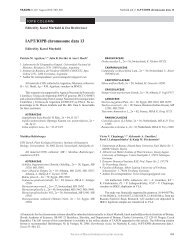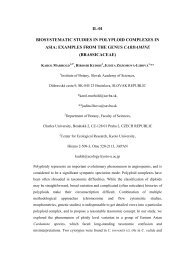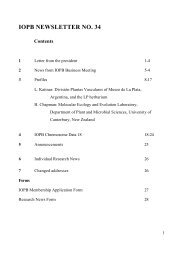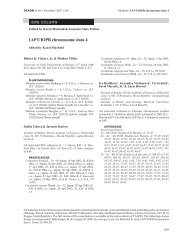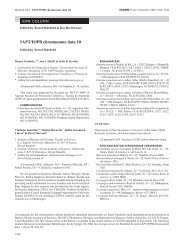CONTENS - International Organization of Plant Biosystematists
CONTENS - International Organization of Plant Biosystematists
CONTENS - International Organization of Plant Biosystematists
Create successful ePaper yourself
Turn your PDF publications into a flip-book with our unique Google optimized e-Paper software.
O 43<br />
Polyploid evolution in rock outcrop mountains <strong>of</strong> South-Eastern<br />
Brazil<br />
Itayguara Ribeiro da Costa & Eliana Regina Forni-Martins<br />
Department <strong>of</strong> Botany, Institute <strong>of</strong> Biology, University <strong>of</strong> Campinas - UNICAMP,<br />
Cidade Universitária Zeferino Vaz, s/n, Caixa Postal 6109, CEP 13083-970,<br />
Campinas – SP, Brazil; itayguara@gmail.com, elianafm@unicamp.br.<br />
The rock outcrop complexes in South-Eastern Brazil are mainly part <strong>of</strong> the Espinhaço<br />
(campos rupestres) and Mantiqueira Range (campos de altitude), belong to Brazilian<br />
Cerrado and Atlantic Tropical Rain Forest biomes. The high elevation formations, the<br />
relicts, are characterized by poor soils and daily extreme temperatures, occurring<br />
above 900 and 1500 m <strong>of</strong> altitude, respectively, and possess a peculiar flora with<br />
high levels <strong>of</strong> endemism. Myrtaceae have widespread distribution at all Brazilian<br />
vegetation formations and present a high taxonomic complexity with hybrid species.<br />
The chromosome number for this family showed high frequency <strong>of</strong> 2n = 22 (x = 11),<br />
with the occurrence <strong>of</strong> polyploidy in several species, including the polyploid<br />
cytotypes. We carried out chromosome counts for ca. 80 species <strong>of</strong> Brazilian<br />
Myrtaceae in several genera, aiming to determine if occurrence <strong>of</strong> polyploidy would<br />
be associated with the distribution <strong>of</strong> some species in these environments. We found<br />
eight pairs <strong>of</strong> cytotypes and four different ploidy levels (2x, 3x, 4x and 6x) distributed<br />
in three genera. The greatest ploidy levels (3x and 4x) were found in some species <strong>of</strong><br />
Eugenia and Myrcia occurring in campos rupestres against the diploid relatives in the<br />
Cerrado vegetation. Similar situation to Psidium, where 6x populations occurs at<br />
highest altitude <strong>of</strong> Mantiqueira Range while 4x is distributed in other Atlantic Tropical<br />
Rain Forest localities with lower altitudes, next to the sea level. Higher ploidy levels<br />
were also observed by others authors in species <strong>of</strong> other families, as Bromeliaceae,<br />
Velloziaceae, Orchidaceae and Xyridaceae, occurring in these rock outcrop<br />
mountains. In the future, studies will be conduced to explain the origin <strong>of</strong> polyploid<br />
cytotypes in these differential environments.<br />
44



